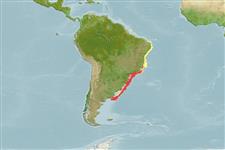Environment: milieu / climate zone / depth range / distribution range
Écologie
marin démersal; profondeur 80 - 215 m (Ref. 47377), usually 80 - 200 m (Ref. 27363). Subtropical; - 40°S
Southwest Atlantic: [Uruguay to northern Argentina according to Ref. 27363]; south of Rio Grande to Argentina (Ref. 47377).
Length at first maturity / Taille / Poids / Âge
Maturity: Lm 18.0, range 14 - 24 cm
Max length : 45.0 cm TL mâle / non sexé; (Ref. 47377); common length : 27.9 cm SL mâle / non sexé; (Ref. 27363)
Description synthétique
Clés d'identification | Morphologie | Morphométrie
Épines dorsales (Total) : 12; Rayons mous dorsaux (Total) : 12; Épines anales: 3; Rayons mous anaux: 5. Body orange-red dorsally; side more or less spotted or mottled with vermillion color; lower part pinkish white; dorsal fin membranes with dark spots and blotches; pectoral, pelvic and anal fins reddish (Ref. 27363).
Life cycle and mating behavior
Maturities | Reproduction | Spawnings | Egg(s) | Fecundities | Larves
Nakamura, I., T. Inada, M. Takeda and H. Hatanaka, 1986. Important fishes trawled off Patagonia. Japan Marine Fishery Resource Research Center, Tokyo. 369 p. (Ref. 27363)
Statut dans la liste rouge de l'IUCN (Ref. 130435)
Menace pour l'homme
Harmless
Utilisations par l'homme
Outils
Articles particuliers
Télécharger en XML
Sources Internet
Estimates based on models
Preferred temperature (Ref.
123201): 5.4 - 19.1, mean 17.2 °C (based on 50 cells).
Phylogenetic diversity index (Ref.
82804): PD
50 = 0.5020 [Uniqueness, from 0.5 = low to 2.0 = high].
Bayesian length-weight: a=0.00955 (0.00636 - 0.01435), b=3.13 (3.01 - 3.25), in cm total length, based on LWR estimates for this species & (Sub)family-body (Ref.
93245).
Niveau trophique (Ref.
69278): 4.2 ±0.2 se; based on diet studies.
Generation time: 54.9 ( na - na) years. Estimated as median ln(3)/K based on 2
growth studies.
Résilience (Ref.
120179): Très faible, temps minimum de doublement de population supérieur à 14 ans (tm=14-24; K=0.02).
Fishing Vulnerability (Ref.
59153): Low to moderate vulnerability (35 of 100).
